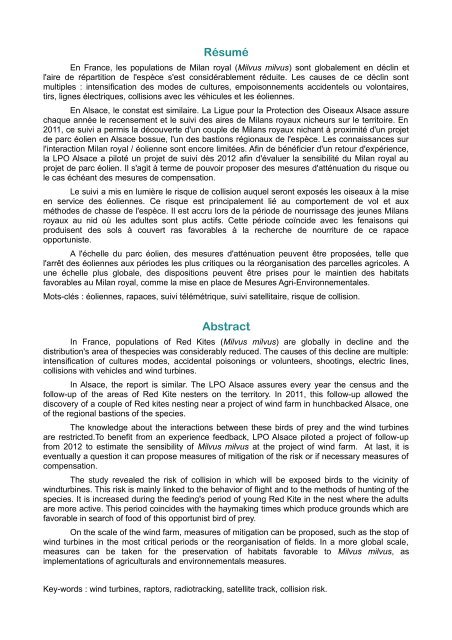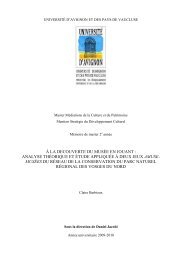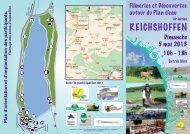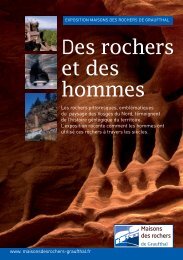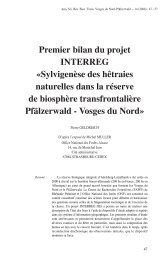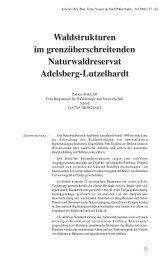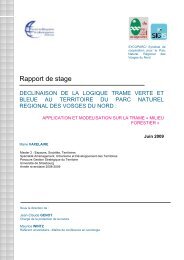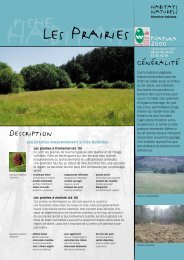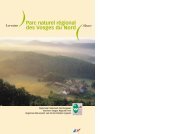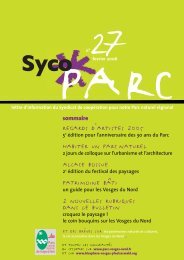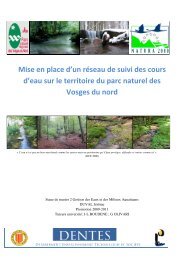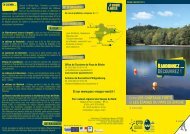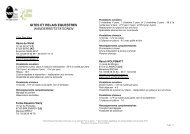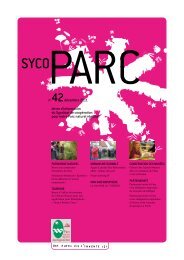Télécharger le pdf - Parc naturel régional des Vosges du Nord
Télécharger le pdf - Parc naturel régional des Vosges du Nord
Télécharger le pdf - Parc naturel régional des Vosges du Nord
You also want an ePaper? Increase the reach of your titles
YUMPU automatically turns print PDFs into web optimized ePapers that Google loves.
Résumé<br />
En France, <strong>le</strong>s populations de Milan royal (Milvus milvus) sont globa<strong>le</strong>ment en déclin et<br />
l'aire de répartition de l'espèce s'est considérab<strong>le</strong>ment ré<strong>du</strong>ite. Les causes de ce déclin sont<br />
multip<strong>le</strong>s : intensification <strong>des</strong> mo<strong>des</strong> de cultures, empoisonnements accidentels ou volontaires,<br />
tirs, lignes é<strong>le</strong>ctriques, collisions avec <strong>le</strong>s véhicu<strong>le</strong>s et <strong>le</strong>s éoliennes.<br />
En Alsace, <strong>le</strong> constat est similaire. La Ligue pour la Protection <strong>des</strong> Oiseaux Alsace assure<br />
chaque année <strong>le</strong> recensement et <strong>le</strong> suivi <strong>des</strong> aires de Milans royaux nicheurs sur <strong>le</strong> territoire. En<br />
2011, ce suivi a permis la découverte d'un coup<strong>le</strong> de Milans royaux nichant à proximité d'un projet<br />
de parc éolien en Alsace bossue, l'un <strong>des</strong> bastions régionaux de l'espèce. Les connaissances sur<br />
l'interaction Milan royal / éolienne sont encore limitées. Afin de bénéficier d'un retour d'expérience,<br />
la LPO Alsace a piloté un projet de suivi dès 2012 afin d'évaluer la sensibilité <strong>du</strong> Milan royal au<br />
projet de parc éolien. Il s'agit à terme de pouvoir proposer <strong>des</strong> mesures d'atténuation <strong>du</strong> risque ou<br />
<strong>le</strong> cas échéant <strong>des</strong> mesures de compensation.<br />
Le suivi a mis en lumière <strong>le</strong> risque de collision auquel seront exposés <strong>le</strong>s oiseaux à la mise<br />
en service <strong>des</strong> éoliennes. Ce risque est principa<strong>le</strong>ment lié au comportement de vol et aux<br />
métho<strong>des</strong> de chasse de l'espèce. Il est accru lors de la période de nourrissage <strong>des</strong> jeunes Milans<br />
royaux au nid où <strong>le</strong>s a<strong>du</strong>ltes sont plus actifs. Cette période coïncide avec <strong>le</strong>s fenaisons qui<br />
pro<strong>du</strong>isent <strong>des</strong> sols à couvert ras favorab<strong>le</strong>s à la recherche de nourriture de ce rapace<br />
opportuniste.<br />
A l'échel<strong>le</strong> <strong>du</strong> parc éolien, <strong>des</strong> mesures d'atténuation peuvent être proposées, tel<strong>le</strong> que<br />
l'arrêt <strong>des</strong> éoliennes aux pério<strong>des</strong> <strong>le</strong>s plus critiques ou la réorganisation <strong>des</strong> parcel<strong>le</strong>s agrico<strong>le</strong>s. A<br />
une échel<strong>le</strong> plus globa<strong>le</strong>, <strong>des</strong> dispositions peuvent être prises pour <strong>le</strong> maintien <strong>des</strong> habitats<br />
favorab<strong>le</strong>s au Milan royal, comme la mise en place de Mesures Agri-Environnementa<strong>le</strong>s.<br />
Mots-clés : éoliennes, rapaces, suivi télémétrique, suivi satellitaire, risque de collision.<br />
Abstract<br />
In France, populations of Red Kites (Milvus milvus) are globally in decline and the<br />
distribution's area of thespecies was considerably re<strong>du</strong>ced. The causes of this decline are multip<strong>le</strong>:<br />
intensification of cultures mo<strong>des</strong>, accidental poisonings or volunteers, shootings, e<strong>le</strong>ctric lines,<br />
collisions with vehic<strong>le</strong>s and wind turbines.<br />
In Alsace, the report is similar. The LPO Alsace assures every year the census and the<br />
follow-up of the areas of Red Kite nesters on the territory. In 2011, this follow-up allowed the<br />
discovery of a coup<strong>le</strong> of Red kites nesting near a project of wind farm in hunchbacked Alsace, one<br />
of the regional bastions of the species.<br />
The know<strong>le</strong>dge about the interactions between these birds of prey and the wind turbines<br />
are restricted.To benefit from an experience feedback, LPO Alsace piloted a project of follow-up<br />
from 2012 to estimate the sensibility of Milvus milvus at the project of wind farm. At last, it is<br />
eventually a question it can propose measures of mitigation of the risk or if necessary measures of<br />
compensation.<br />
The study revea<strong>le</strong>d the risk of collision in which will be exposed birds to the vicinity of<br />
windturbines. This risk is mainly linked to the behavior of flight and to the methods of hunting of the<br />
species. It is increased <strong>du</strong>ring the feeding's period of young Red Kite in the nest where the a<strong>du</strong>lts<br />
are more active. This period coinci<strong>des</strong> with the haymaking times which pro<strong>du</strong>ce grounds which are<br />
favorab<strong>le</strong> in search of food of this opportunist bird of prey.<br />
On the sca<strong>le</strong> of the wind farm, measures of mitigation can be proposed, such as the stop of<br />
wind turbines in the most critical periods or the reorganisation of fields. In a more global sca<strong>le</strong>,<br />
measures can be taken for the preservation of habitats favorab<strong>le</strong> to Milvus milvus, as<br />
imp<strong>le</strong>mentations of agriculturals and environnementals measures.<br />
Key-words : wind turbines, raptors, radiotracking, satellite track, collision risk.


